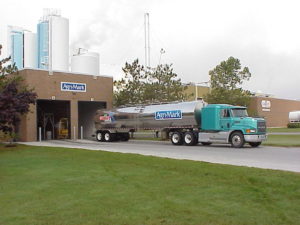 While many foods might be difficult to harvest during the winter months in New England, that doesn’t stop dairy farmers! 365 days a year, New England dairy farm families are hard at work producing a wholesome, nutritious product that goes from the farm to your glass in as little as two days. It doesn’t get much fresher than that!
While many foods might be difficult to harvest during the winter months in New England, that doesn’t stop dairy farmers! 365 days a year, New England dairy farm families are hard at work producing a wholesome, nutritious product that goes from the farm to your glass in as little as two days. It doesn’t get much fresher than that!
Learn how milk gets from the farm to you in 48 hours! Watch the video!
Stage 1: On the Farm
Cows on the farm are milked two or three times per day for about 7 minutes each time – talk about a short work day!
 Dairy farmers care for their cows year round – milk is always in season and always fresh!
Dairy farmers care for their cows year round – milk is always in season and always fresh!
Happy, comfortable cows produce better quality milk, and more of it. It’s in the farmer’s best interest to take care of his herd.
Stage 2: Transportation
 An insulated, refrigerated milk truck arrives at the farm every day or every other day to pick up the milk. The milk is tested before it is loaded.
An insulated, refrigerated milk truck arrives at the farm every day or every other day to pick up the milk. The milk is tested before it is loaded.
Milk is tested more than any other food we consume (an average of 9 times!) to ensure it is fresh, clean, and safe.
Stage 3: Processing
Milk arrives at the processing plant and is tested.
The milk must be clean, free of antibiotics, free of medication, free of artificial hormones, fresh, and high-quality in order to be accepted. If it does not meet these requirements, the milk will not be used.
- Milk is pasteurized
(treated with mild heat to eliminate pathogens) - Milk is homogenized
(shaken to prevent the cream from rising to the top of your milk) - Milk is bottled, labeled, and put on a refrigerated truck.
 Milk might also be made into butter, sour cream, cottage cheese, cheese, whey powder or a number of other dairy products.
Milk might also be made into butter, sour cream, cottage cheese, cheese, whey powder or a number of other dairy products.
The milk supply chain is ultra efficient. Many different brands might be packaged and labeled in the same plant – Cabot, Hood, Friendly’s, Garelick, store brands, etc.
Stage 4: Distribution
Refrigerated trucks move bottled milk to distribution centers, schools, restaurants, and your local grocery store.
The milk in your grocery store is locally grown and locally processed! How else would this product get to you in just 48 hours!?
Stage 5: Your Fridge
Fresh, wholesome, nutritious – choosing local dairy…
1. keeps your dollars local
2. stewards open space
3. protects wildlife and ground water and
4. preserves New England heritage.
 Make sure your milk is local – check your dairy product label and use whereismymilkfrom.com to be sure you are supporting New England dairy farmers.
Make sure your milk is local – check your dairy product label and use whereismymilkfrom.com to be sure you are supporting New England dairy farmers.
Walmart, Aldi, Trader Joes, BJs, Costco and other national box stores might get their milk for cheaper elsewhere. Avoid buying dairy products from these retailers if you want to support New England agriculture.
Some good options for buying local milk: purchase directly from the farmer or other farmstands, small retailers, Big Y, Stop & Shop, or Whole Foods.
Moving Milk
Some big retailers like Walmart or Costco will get milk for a cheaper price outside of New England. Flooding the market with cheap milk is not good news for New England dairy farmers – or their communities.
Some New England milk will be exported overseas – mostly in the form of whey powdered milk or as cheese. Losing markets due to trade wars causes price volatility, a big issue for dairy farmers in New England.
Some cheese and dairy products will be sent to markets outside of New England via large retailers. For the most part, however, dairy raised in New England, stays in New England!
